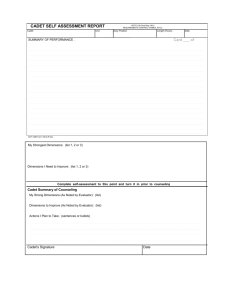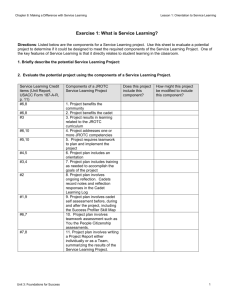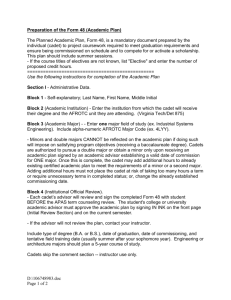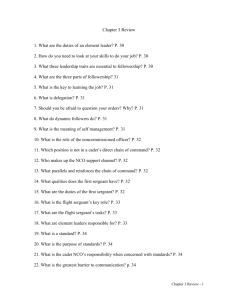TUSKEGEE UNIVERSITY 15TH CADET WING FEBRUARY 2013
advertisement
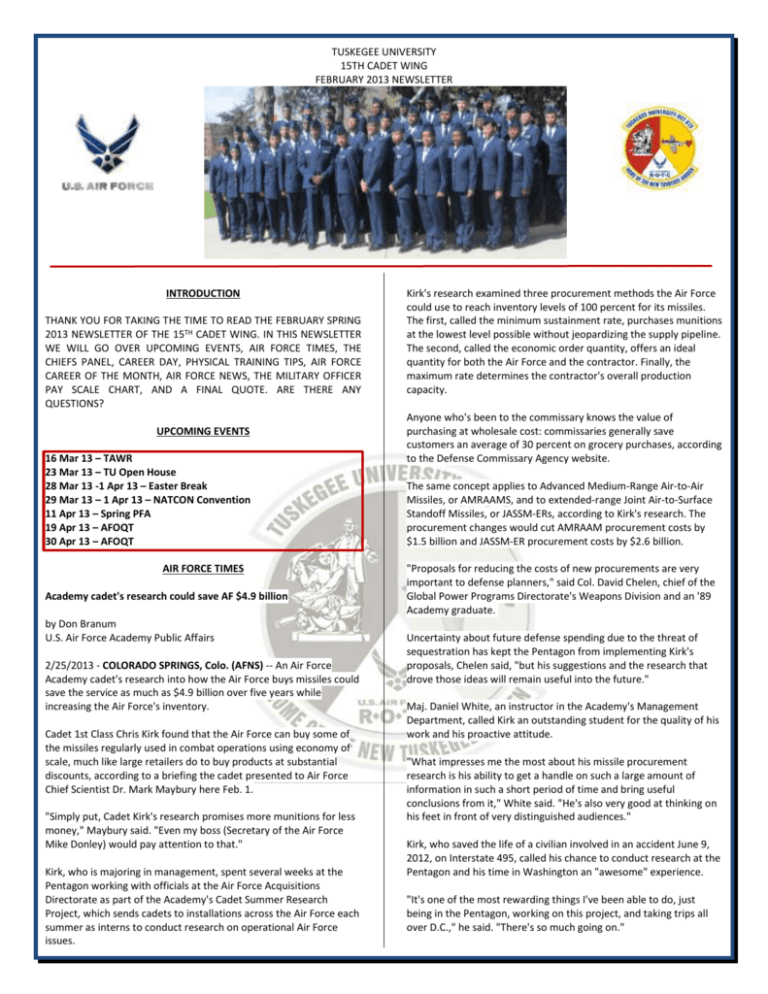
TUSKEGEE UNIVERSITY 15TH CADET WING FEBRUARY 2013 NEWSLETTER INTRODUCTION THANK YOU FOR TAKING THE TIME TO READ THE FEBRUARY SPRING 2013 NEWSLETTER OF THE 15TH CADET WING. IN THIS NEWSLETTER WE WILL GO OVER UPCOMING EVENTS, AIR FORCE TIMES, THE CHIEFS PANEL, CAREER DAY, PHYSICAL TRAINING TIPS, AIR FORCE CAREER OF THE MONTH, AIR FORCE NEWS, THE MILITARY OFFICER PAY SCALE CHART, AND A FINAL QUOTE. ARE THERE ANY QUESTIONS? UPCOMING EVENTS 16 Mar 13 – TAWR 23 Mar 13 – TU Open House 28 Mar 13 -1 Apr 13 – Easter Break 29 Mar 13 – 1 Apr 13 – NATCON Convention 11 Apr 13 – Spring PFA 19 Apr 13 – AFOQT 30 Apr 13 – AFOQT AIR FORCE TIMES Academy cadet's research could save AF $4.9 billion by Don Branum U.S. Air Force Academy Public Affairs 2/25/2013 - COLORADO SPRINGS, Colo. (AFNS) -- An Air Force Academy cadet's research into how the Air Force buys missiles could save the service as much as $4.9 billion over five years while increasing the Air Force's inventory. Cadet 1st Class Chris Kirk found that the Air Force can buy some of the missiles regularly used in combat operations using economy of scale, much like large retailers do to buy products at substantial discounts, according to a briefing the cadet presented to Air Force Chief Scientist Dr. Mark Maybury here Feb. 1. "Simply put, Cadet Kirk's research promises more munitions for less money," Maybury said. "Even my boss (Secretary of the Air Force Mike Donley) would pay attention to that." Kirk, who is majoring in management, spent several weeks at the Pentagon working with officials at the Air Force Acquisitions Directorate as part of the Academy's Cadet Summer Research Project, which sends cadets to installations across the Air Force each summer as interns to conduct research on operational Air Force issues. Kirk's research examined three procurement methods the Air Force could use to reach inventory levels of 100 percent for its missiles. The first, called the minimum sustainment rate, purchases munitions at the lowest level possible without jeopardizing the supply pipeline. The second, called the economic order quantity, offers an ideal quantity for both the Air Force and the contractor. Finally, the maximum rate determines the contractor's overall production capacity. Anyone who's been to the commissary knows the value of purchasing at wholesale cost: commissaries generally save customers an average of 30 percent on grocery purchases, according to the Defense Commissary Agency website. The same concept applies to Advanced Medium-Range Air-to-Air Missiles, or AMRAAMS, and to extended-range Joint Air-to-Surface Standoff Missiles, or JASSM-ERs, according to Kirk's research. The procurement changes would cut AMRAAM procurement costs by $1.5 billion and JASSM-ER procurement costs by $2.6 billion. "Proposals for reducing the costs of new procurements are very important to defense planners," said Col. David Chelen, chief of the Global Power Programs Directorate's Weapons Division and an '89 Academy graduate. Uncertainty about future defense spending due to the threat of sequestration has kept the Pentagon from implementing Kirk's proposals, Chelen said, "but his suggestions and the research that drove those ideas will remain useful into the future." Maj. Daniel White, an instructor in the Academy's Management Department, called Kirk an outstanding student for the quality of his work and his proactive attitude. "What impresses me the most about his missile procurement research is his ability to get a handle on such a large amount of information in such a short period of time and bring useful conclusions from it," White said. "He's also very good at thinking on his feet in front of very distinguished audiences." Kirk, who saved the life of a civilian involved in an accident June 9, 2012, on Interstate 495, called his chance to conduct research at the Pentagon and his time in Washington an "awesome" experience. "It's one of the most rewarding things I've been able to do, just being in the Pentagon, working on this project, and taking trips all over D.C.," he said. "There's so much going on." CHIEF’S PANEL Air Force ROTC Cadets from Auburn University joined cadets from Tuskegee University in a panel involving Chief Master Sergeant’s, the elite group of enlisted personnel in the Air Force. Chief Master Sergeant (CMSgt) is the ninth, and highest, enlisted rank in the U.S. Air Force, and is a senior non-commissioned officer. Attaining the rank of Chief Master Sergeant is the pinnacle of an Air Force enlisted member's career. Some Chief Master Sergeants manage the efforts of all enlisted personnel within their unit or major subsection thereof, while others run major staff functions at higher headquarters levels. All Chief Master Sergeants are expected to serve as mentors for company-grade and field-grade commissioned officers, as well as noncommissioned officers and junior enlisted members, and to serve as advisors to unit commanders and senior officers. By federal law, only one percent of the Air Force enlisted AFROTC CAREER DAY force may hold the rank of Chief Master Sergeant. The following are photos taken at the event. On 20 February, 2013, the 15th Cadet Wing was visited by numerous established Active Duty Air Force Officers that provided insight and inspiration to the cadets. The following is a list of careers that were present and a brief description of the career tasks and relevant interest and skills suggested to pursue this career in the Air Force. AIRCRAFT MAINTENANCE OFFICER: CIVIL ENGINEER: CYBERSPACE OPERATION OFFICER: AIR FORCE CAREER OF THE MONTH: SPACE AND MISSILE OPERATIONS OFFICER JUDGE ADVOCATE OFFICER: MUNITIONS AND MISSILE MAINTENANCE OFFICER: AIR FORCE NEWS PILOT: CSAF discusses impact of sequester by Karen Parrish American Forces Press Service 2/27/2013 - WASHINGTON (AFPS) -- America's military superiority is founded on training and readiness, and the fiscal crisis facing the country threatens to strip away that edge, members of the Joint Chiefs of Staff told Congress Feb. 26. Air Force Chief of Staff Gen. Mark A. Welsh III, along with Army Chief of Staff Gen. Ray Odierno, Chief of Naval Operations Adm. Jonathan W. Greenert, Marine Corps Commandant Gen. James F. Amos and National Guard Bureau Chief Army Gen. Frank J. Grass, testified before the House Appropriations Committee's defense subcommittee on fiscal challenges facing the Department of Defense. The chiefs discussed the effects of sequester -- $47 billion in acrossthe-board 2013 defense spending cuts that will take effect March 1 if Congress doesn't act -- and the continuing resolution, which guides government spending in the absence of an approved budget. If sequestration occurs, "it will significantly undermine your Air Force's readiness and responsiveness today," Welsh said. "It will significantly impact our civilian workforce in the coming months. And its impact on modernization will clearly affect our future capability." Welsh said two-thirds of Air Force combat units will curtail flying training starting in March. "They'll drop below acceptable readiness levels, by our definitions, by mid-May," he added. "Most will be completely non-mission-capable as a unit by July." If a 2014 budget is in place by October, he said, it will take the Air Force six months to regain its present level of training. The chiefs asked for Congress' help in giving them some spending flexibility if the continuing resolution remains. Authority to move funds between accounts could help prevent the current unavoidable waste Greenert decried in the Navy. The shortfall created by the continuing resolution, he said, "has compelled us to cancel ship and aircraft maintenance, reduce operations, curtail training for forces that will soon deploy, and [notify] 186,000 of our civilians of a possible furlough." "We've lost $600 million in February because of ... just lost opportunities," the Navy's top officer said. "Through the month of March, if we don't have that opportunity to reallocate funds, it would be another $1.2 billion, and it just continues to grow and cascade as we go through the summer." Greenert told the panel an appropriations bill for this fiscal year is necessary to allow the department to distribute resources in a deliberate manner. The Army chief said he started his career in a hollow Army, and he doesn't want to end it there. "We simply cannot take the readiness of our force for granted," he said. "If we do not have the resources to train and equip the force, our soldiers -- our young men and women -- are the ones who will pay the price, potentially with their lives." http://www.af.mil/news/story.asp?id=123337978 PHYSICAL TRAINING TIPS 1. Try a training regimen! Go to military.com/militaryfitness. Physical training on Mondays and Thursdays won’t get you ready for the PFA. 2. Attend Insanity workouts with Cadet Bush 3. Find a wingman and run around campus 4. Go to the gym in Logan Hall! The hours are Monday – Friday 06001000, 1400-2000 and Saturday 0800-1300. 5. Attend the extra physical training session on Friday’s at 0600. http://www.military.com/military-fitness/fitness-testprep/weights-and-pt-workouts QUOTE “Leadership is intangible, therefore no weapon ever designed can replace it.” - General Omar Bradley 2013 MILITARY OFFICER PAY SCALE CHART
